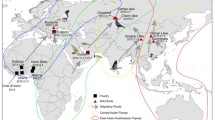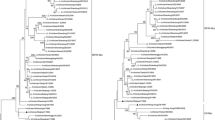Abstract
In spring 2009, one strain of H5N1 clade 2.3.2 virus was isolated from wild swans in Shanghai, indicating the importance of the wild swan in the ecology of this highly pathogenic avian influenza virus (HPAIV) in Eastern China. Pathogenicity experiments conducted in this study indicated that the virus was highly pathogenic for chickens but lowly pathogenic for mammalian hosts, as evidenced by reduced infection of mice. The analysis of complete genome sequences and genetic evolution showed that A/Swan/Shanghai/10/09 (SW/SH/09) may be derived from the strain A/silky chicken/Shantou/475/2004 (CK/ST/04), which is homologous to the influenza viruses isolated from chicken, duck, pika, little egret, swan, mandarin duck and bar-headed goose in China Hunan, China Qinghai, Mongolia, Russia, Japan, Korea, Laos and Hong Kong during 2007–2011, indicating that the virus has retro-infected diverse wild birds from chicken, and significant spread of the virus is still ongoing through overlapping migratory flyways. On the basis of the molecular analysis, we also found that there was a deletion of the glycosylation site (NSS) in amino acid 156 of the hemagglutinin (HA) protein when compared with that of the other Clade 2.3.2 viruses isolated between 2007 and 2011. More importantly, the sequence analysis of SW/SH/09 virus displayed the drug-resistant mutations on the matrix protein (M2) and neuraminidase (NA) genes.



Similar content being viewed by others
References
X. Xu et al., Genetic characterization of the pathogenic influenza A/Goose/Guangdong/1/96 (H5N1) virus: similarity of its hemagglutinin gene to those of H5N1 viruses from the 1997 outbreaks in Hong Kong. Virology 261(1), 15–19 (1999)
Y. Guan et al., Molecular epidemiology of H5N1 avian influenza. Rev. Sci. Tech. 28(1), 39–47 (2009)
H. Chen et al., Avian flu: H5N1 virus outbreak in migratory waterfowl. Nature 436(7048), 191–192 (2005)
J. Liu et al., Highly pathogenic H5N1 influenza virus infection in migratory birds. Science 309(5738), 1206 (2005)
World Health Organization (2007). Recommendations and laboratory procedures for detection of avian influenza A(H5N1) virus in specimens from suspected human cases. http://www.who.int/entity/csr/disease/avianinfluenza/guidelines/RecAIlabtestsAug07.pdf
H.K. Chang et al., Development of multiplex RT-PCR assays for rapid detection and subtyping of influenza type A viruses from clinical specimens. J. Microbiol. Biotechnol. 18(6), 1164–1169 (2008)
B.F. Qiu et al., A reverse transcription-PCR for subtyping of the neuraminidase of avian influenza viruses. J. Virol. Methods 155(2), 193–198 (2009)
E. Hoffmann et al., Universal primer set for the full-length amplification of all influenza A viruses. Arch. Virol. 146(12), 2275–2289 (2001)
A. Stieneke-Grober et al., Influenza virus hemagglutinin with multibasic cleavage site is activated by furin, a subtilisin-like endoprotease. EMBO J. 11(7), 2407–2414 (1992)
Y. Ha et al., X-ray structures of H5 avian and H9 swine influenza virus hemagglutinins bound to avian and human receptor analogs. Proc. Natl. Acad. Sci. USA 98(20), 11181–11186 (2001)
J. Stevens et al., Structure and receptor specificity of the hemagglutinin from an H5N1 influenza virus. Science 312(5772), 404–410 (2006)
M. Philpott, B.C. Easterday, V.S. Hinshaw, Neutralizing epitopes of the H5 hemagglutinin from a virulent avian influenza virus and their relationship to pathogenicity. J. Virol. 63(8), 3453–3458 (1989)
M. Philpott et al., Hemagglutinin mutations related to attenuation and altered cell tropism of a virulent avian influenza A virus. J. Virol. 64(6), 2941–2947 (1990)
N.V. Kaverin et al., Structure of antigenic sites on the haemagglutinin molecule of H5 avian influenza virus and phenotypic variation of escape mutants. J. Gen. Virol. 83(Pt 10), 2497–2505 (2002)
N.V. Kaverin et al., Epitope mapping of the hemagglutinin molecule of a highly pathogenic H5N1 influenza virus by using monoclonal antibodies. J. Virol. 81(23), 12911–12917 (2007)
Q.M. Le et al., Avian flu: isolation of drug-resistant H5N1 virus. Nature 437(7062), 1108 (2005)
P.J. Collins et al., Crystal structures of oseltamivir-resistant influenza virus neuraminidase mutants. Nature 453(7199), 1258–1261 (2008)
Z. Li et al., Molecular basis of replication of duck H5N1 influenza viruses in a mammalian mouse model. J. Virol. 79(18), 12058–12064 (2005)
M. Hatta et al., Molecular basis for high virulence of Hong Kong H5N1 influenza A viruses. Science 293(5536), 1840–1842 (2001)
C. Scholtissek et al., How to overcome resistance of influenza A viruses against adamantane derivatives. Antiviral Res. 37(2), 83–95 (1998)
S.H. Seo, E. Hoffmann, R.G. Webster, The NS1 gene of H5N1 influenza viruses circumvents the host anti-viral cytokine responses. Virus Res. 103(1–2), 107–113 (2004)
T.M. Ellis et al., Investigation of outbreaks of highly pathogenic H5N1 avian influenza in waterfowl and wild birds in Hong Kong in late 2002. Avian Pathol. 33(5), 492–505 (2004)
Acknowledgments
This study was supported by the Major State Basic Research Development Program (973 Program) (No. 2011CB505003), the Important National Science & Technology Specific Projects (No. 2008ZX10004-013 and 2009ZX10004-214), the National Key Technologies R&D Program of China (No. 2010BAD04B01), and the Jiangsu High School Natural Science Foundation (No. 10KJA230055).
Author information
Authors and Affiliations
Corresponding author
Rights and permissions
About this article
Cite this article
Zhao, G., Zhong, L., Lu, X. et al. Characterisation of a highly pathogenic H5N1 clade 2.3.2 influenza virus isolated from swans in Shanghai, China. Virus Genes 44, 55–62 (2012). https://doi.org/10.1007/s11262-011-0667-8
Received:
Accepted:
Published:
Issue Date:
DOI: https://doi.org/10.1007/s11262-011-0667-8




